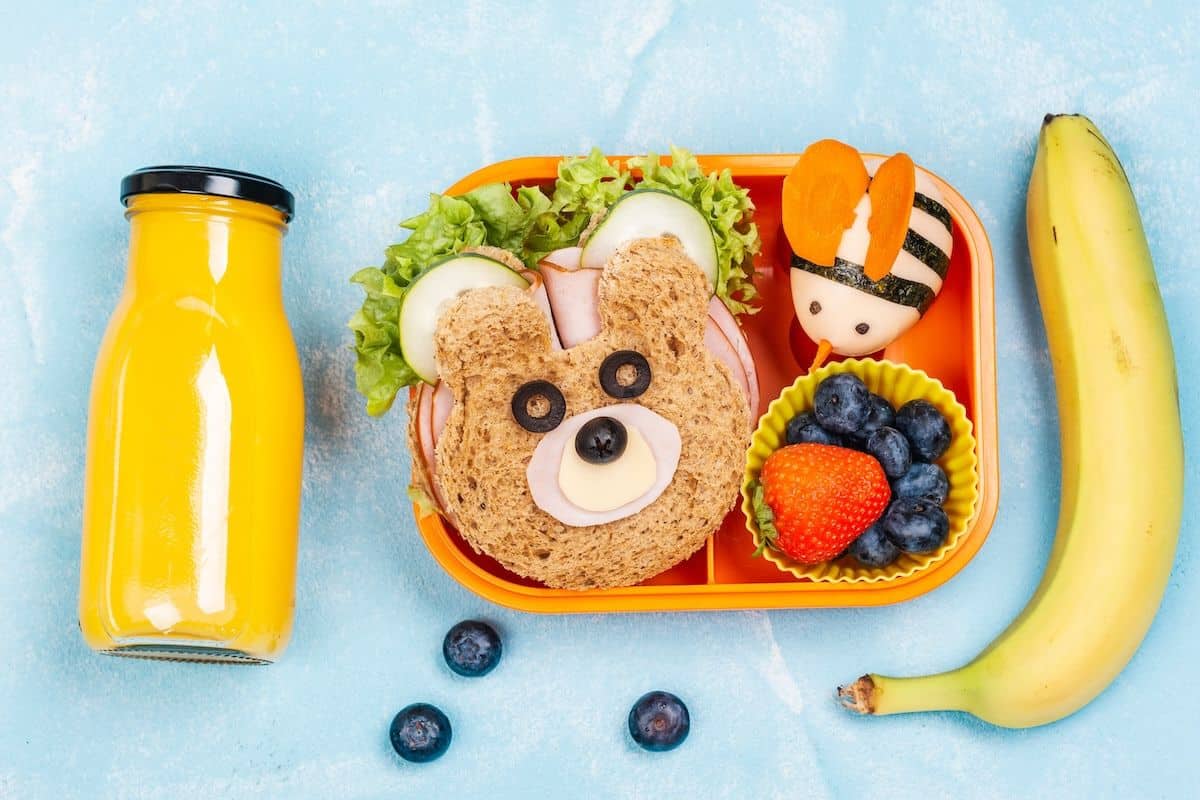Clean Eating for Kids – 9 Tips From a Nutritionist
It can be challenging to teach children healthy eating behaviors. In this article, I share 9 practical tips for raising kids to enjoy eating a clean eating diet. These are tried and true ways to get kids involved with healthy foods for a lifetime.

Challenges of Raising Healthy Kids
Ask any parent about the biggest challenge they face when trying to encourage healthy eating in their kids, and lack of time will invariably be at the top of the list.
Financial constraints can be another issue. Healthy eating is perceived as being expensive, and cheap, processed foods that require little preparation can seem an attractive option.
Then there is slick marketing to contend with. Children are bombarded throughout the day with images of junk food, convenience food, and drinks designed to look incredibly tempting.
They are also encouraged to opt for “healthy” foods like cereals, yogurts, and juices, which may appear nutritious but are often packed with sugar or sweeteners, and other undesirable ingredients.
Indulgent relatives can make life difficult, too, providing candy and other sweet foods as a means of spoiling children. Not only can this behavior introduce added sugars into your child’s diet, but it can also give the impression that unhealthy foods are treats whereas nutritious foods are less desirable.
Last but not least is the challenge of peer pressure. Kids are pretty good at making parents feel guilty if they see themselves as the only ones “deprived” of junk foods, so it can be tempting to give in for a quiet life.
9 Clean Eating Tips for Kids
Here are some simple steps you can take to overcome the barriers to healthy eating and encourage children to make nutritious choices now and into the future.
1. Model clean eating behavior
Our children imitate everything we do – indeed, it’s the way they learn the most basic behaviors.
Yet we tend to overlook this when it comes to our own diets. It can be easy to grab a processed snack for ourselves while trying to encourage our kids to make healthier food choices.
Studies have shown just how detrimental this can be, concluding that parental food habits are the most important factor in influencing a child’s eating behaviors and food choices.
To model clean eating behavior to your kids, ensure your fridge and pantry are stocked with wholesome ingredients, not processed foods and packaged snacks. Make a home-cooked meal as often as possible using different types of foods.
Eat the foods that you want your child to eat and be open to trying new foods right along with them.
2. Eat together as a family
Modern life can make it hard to coordinate the time to sit together and eat as a family, but the benefits are so important that it’s worth doing so as often as you can.
Studies have shown that sharing meals as a family results in better dietary choices, with children consuming more fruits, vegetables, and nutritious foods.
Eating together doesn’t just establish positive associations with food, but it is also great for our kids’ mental health.
What’s more, studies have shown that the benefits associated with eating together as a family do not just apply to “happy” households. They can still be seen in regular families where the atmosphere around the dinner table may sometimes be less than harmonious.
The bottom line is that the dinner table can be a place where all sorts of discussions, interactions, and relationships are built. It’s a time when we can slow down and nourish ourselves together. The conversations that come up during family meals can be life changing for both the parents and children.
3. Get your child involved with food preparation
While many of us spend time in the kitchen with our kids when they’re very small, it’s something we tend to do less and less as they get older. But involving children in every stage of meal preparation can have a real and lasting impact on their relationship with food.
Research involving 47 children aged from 6 to 10 years found that kids who prepared food with their parents ate significantly more nutritious foods than those who had no involvement in the process. They also experienced greater feelings of positivity and control.
Involving your child can start at the planning process – deciding on a weekly menu, for example, and writing a grocery list. It can include shopping for the ingredients and then cooking the meal together – a shared experience that creates lasting memories for you both.
4. Be patient with picky eaters
Picky eating is a common problem with a variety of causes, from the late introduction of textured foods to a natural sensitivity to certain tastes and smells.
In some cases, it can lead to nutritional deficiencies, including low iron levels from a low intake of meat and constipation caused by a lack of dietary fiber.
It’s a problem that needs to be approached with care, in order to avoid creating anxieties around eating that will simply compound the issue.
With very young children, the best strategy is to introduce a wide variety of nutritious foods – particularly fruits and vegetables – and offer them repeatedly.
Researchers and nutrition experts have found that repeated exposure to certain foods can encourage children to accept them, even if they disliked them at first.
Though dealing with fussy feeders can be frustrating, keeping your cool is paramount. In order to restore harmony at the dinner table, try:
- Allowing your child’s appetite to develop by avoiding offering too many snacks between scheduled mealtimes.
- Eating delicious meals together as a family and creating a pleasant, enjoyable atmosphere.
- Ensuring your child is properly seated at the table for meals and avoiding distractions like toys and the TV.
- Encouraging self-feeding as much as possible and exploring the concept of baby-led weaning for very young children.
- Introducing new foods and healthy meals regularly.
- Keeping calm when foods are rejected and avoiding trying to bribe or threaten your child.
- Allowing your child to choose how much to eat and never insisting that a plate is cleared.
And, be sure to check out my list of the best and worst vegetables for picky eaters so you have a better idea of what variety of foods to serve.
You might also like this article on how to cook vegetables if you are looking for some additional clean recipes and techniques for making them taste good.
5. Moderate sugar intake, especially added sugars
Many of us are drawn to sweet flavors, an innate characteristic that attracts babies to their mothers’ milk.
But it is important to keep sweet foods in moderation, particularly those containing added – rather than natural – sugars.
Experts acknowledge that most sugars can safely be consumed in small amounts as part of a healthy diet, but that added sugars are associated with an increased risk of cardiovascular disease and obesity.
To cut down on added sugars in your kids’ diets, serve water or milk instead of soda or sweetened fruit drinks. Limit processed foods and check the labels of seemingly healthy foods like cereal.
Even though fruit juice is healthier than sweetened fruit drinks, you should still keep it to a minimum. Whole foods like whole fruit is a better option as it contains less sugar per serving.
6. Encourage fruit and vegetable intake
It’s very important that kids grow up seeing fresh fruits and vegetables as something to be enjoyed rather than tolerated.
High consumption of fresh produce is associated with all sorts of benefits, yet many children eat far less than recommended.
To encourage a better intake of fruits and vegetables:
- Eat plenty yourself, both alongside your main meal and as a snack. Frozen grapes, for example, make a delicious treat, and frozen bananas can be blended to create a healthy ice cream.
- Buy fresh produce when it’s in season. Not only will it taste better, but it will also be cheaper.
- Offer vegetarian versions of popular dishes like lasagna and chili. Try to make healthy recipes using ingredients like sweet potatoes that kids like.
- Pair veggies with healthy fats such as guacamole or a clean ranch-based dressing that kids can use as a dip.
Avoid trying to “hide” vegetables in other dishes (use that as a last resort) – try to encourage an appreciation of them instead.
7. Avoid processed and packaged foods
Processed foods are more popular than ever, offering a convenient solution to busy families trying to juggle the demands of modern life.
But this convenience comes at a cost, with these packaged foods often high in sugar, salt, and unhealthy fats. The result for our kids is significantly lower levels of physical fitness.
But healthy eating and nutrient-dense foods can be convenient too.
You can prepare a simple and nutritious meal from scratch in the same amount of time as it takes to heat many pre-packaged foods such as chicken nuggets or french fries.
Eggs, canned beans, fish, whole grains, and frozen veggies are just a few examples of foods that take just minutes to prepare.
Batch cooking helps too – in one afternoon at the weekend you could make enough kid-friendly recipes to freeze and keep you going throughout the week. Start with a family meal plan and then take the whole family to the grocery store to pick out the ingredients.
For more meal planning and meal prep tips, see my article on Meal Prepping for Beginners.
8. Encourage water hydration
Good hydration is essential for optimal health, but experts recommend this comes primarily from water rather than things like sports drinks and soda.
Unless otherwise indicated from a healthcare provider, the best drink for children is plain, clean water.
To encourage your kids to drink more water:
- Lead by example and drink more water yourself.
- Add a slice of fresh fruit or mint leaves for a boost of flavor.
- Allow your child to pick a fun water bottle that they can take everywhere.
- Try adding a green smoothie for a healthy breakfast that is also hydrating.
9. Emphasize balance and moderation
Food should be enjoyed.
The moment we start overly restricting the foods our kids eat and putting too much emphasis on particular ingredients, we risk damaging that enjoyment and creating an unhealthy relationship with food.
It is important to encourage children to enjoy a wide range of healthy foods, exploring different options with them to establish the ingredients they enjoy the most.
At the same time, children need to understand that moderation is key. As long as the majority of their nutrition comes from fresh and healthy sources, there is no reason they can’t enjoy the occasional less-than-healthy “treat” too!
Try making desserts or treats using healthy ingredients such as energy bites with peanut butter or cookie bars with oats. Some of my favorite recipes include: Peanut Butter Banana Oatmeal Bars and Vegan Pumpkin Brownies.
Sticking with clean eating recipes is an easy way to encourage moderation and the enjoyment of nutritious food.
FAQs
These simple ideas are both nutritious and easy to prepare – ideal for those busy weeknights when you don’t have much time to cook!
Scrambled eggs with cheese and spinach served in a whole wheat pita.
A potato baked in its skin, topped with cooked broccoli, sour cream, and grated cheese.
Homemade soup made with cooked, blended vegetables.
Pan-fried fish served with whole grain brown rice and veggies.
Wraps filled with shredded chicken, fresh salad, and apple slices.
Hummus served with crunchy veggies sticks or warm pita.
Cooked pasta in a simple cheese and tomato sauce.
The best way to get your picky eater to try new foods – including fruits and vegetables – is to sit together and enjoy them as a family.
Some kids want whatever is on their parents’ plates, so if you’re struggling to get them to eat a particular food, try putting it on your plate and not theirs. It may suddenly become a lot more tempting. Only offer new foods in small amounts. Praise your child if they try them, but don’t show any frustration if they don’t! Simply remove them and try offering them again another time.
You might want to consider changing your cooking methods, too. Some kids might not like steamed carrots, but if you try roasting them you might get a completely different reaction.
And don’t try offering any new foods if your child is grouchy – pick a time when they are happy and wide awake. If possible, invite other children of the same age to eat with you, as kids love to mimic others.
Being able to enjoy the odd treat or indulgence alongside a well-balanced, nutritious diet is an important part of healthy eating. Only offer these treats in small amounts and avoid using them as rewards, because this may make them seem even more desirable!
More Clean Eating Articles for Kids
Conclusions
Teaching clean eating habits from childhood is one of the best things you can do for your kids. It fosters a healthy relationship with food that will last a lifetime and supports their growth and development through their early years and beyond. I hope you’ve found these tips helpful in encouraging your child to make good food choices and that you have lots of happy times cooking – and eating – together!
Don’t forget to join my newsletter list to get exclusive clean eating recipes and tips. The newsletter is 100% free with no spam; unsubscribe anytime.
About the Author: Carrie Forrest has a master’s degree in public health with a specialty in nutrition and is a certified holistic nutritionist. She is a top wellness and food blogger with over 5 million annual visitors to her site. Carrie has an incredible story of recovery from chronic illness and is passionate about helping other women transform their health. Send her a message through her contact form.
Note: this post is for informational purposes only and is not intended as medical advice. Please consult your healthcare provider for recommendations related to your individual situation.




















